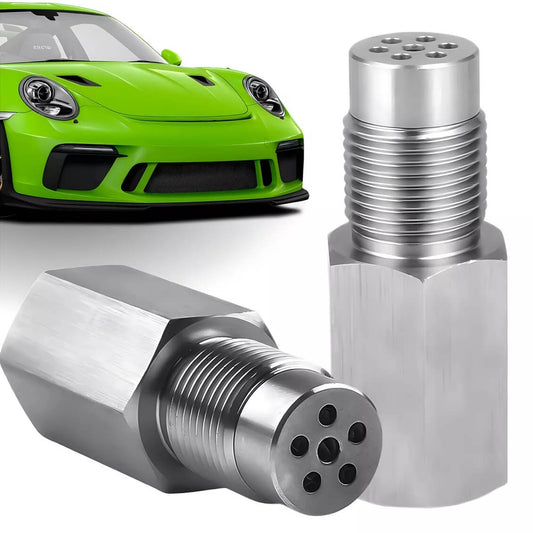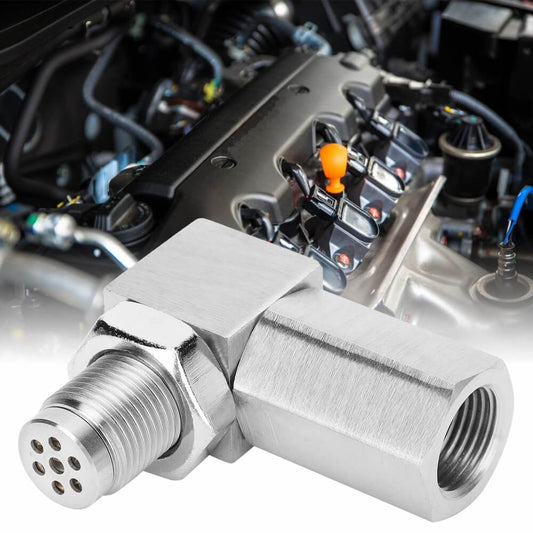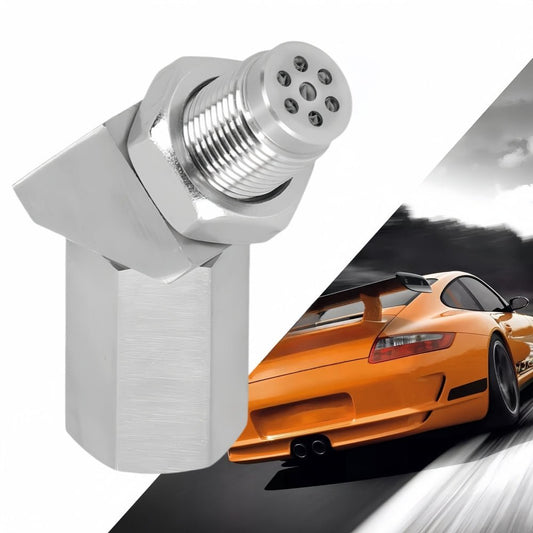How does an o2 sensor spacer work?
Share
In a vehicle’s exhaust system, the oxygen sensor (O2 sensor) plays a crucial role. It monitors the oxygen content in the exhaust gases and relays this information to the engine control unit (ECU) to optimize fuel injection and ignition timing, ensuring efficient engine performance and clean exhaust emissions. However, in certain situations, such as after exhaust system modifications or catalytic converter removal, the original position of the oxygen sensor may no longer be ideal. This is where the O2 sensor spacer comes into play.

Basic Concept of an Oxygen Sensor Spacer
As the name suggests, an oxygen sensor spacer is a device installed between the oxygen sensor and other parts of the exhaust system. It primarily serves two functions: first, to adjust the position of the oxygen sensor relative to the exhaust flow, and second, to process the exhaust gases to some extent through its internal structure. These spacers are typically made from high-temperature and corrosion-resistant materials to ensure stable performance in the harsh environment of the exhaust system.

Detailed Working Principle
1. Position Adjustment:
The most direct function of an oxygen sensor spacer is to adjust the position of the oxygen sensor within the exhaust system. In the original design, oxygen sensors are typically located upstream or downstream of the catalytic converter to monitor changes in oxygen concentration before and after the converter. However, in some modification or repair scenarios, directly replacing or relocating the oxygen sensor may not be feasible. Installing a spacer allows for fine-tuning the sensor’s position, improving the accuracy of oxygen monitoring in the exhaust, and enhancing the precision of engine control.
2. Exhaust Treatment:
Beyond position adjustment, some advanced oxygen sensor spacers also incorporate mini catalytic converters or other processing elements. These components can provide some degree of exhaust treatment, such as reducing temperature or lowering harmful emissions. This is particularly useful for vehicles where the catalytic converter has been removed, as the built-in mini catalytic converter can simulate the function of the original converter to some extent, mitigating exhaust emission issues that may arise from modifications.
3. Signal Stability:
Variations in temperature and pressure within the exhaust system can affect the stability of the oxygen sensor's signal. The presence of an oxygen sensor spacer can buffer these changes to some degree, allowing the sensor to operate more stably. This contributes positively to the stability of engine control and can also extend the lifespan of the oxygen sensor.
4. Resolving Error Codes:
In certain situations, vehicles that have undergone modifications or repairs may trigger engine error codes (such as P0420) due to changes in the exhaust system. In such cases, installing an appropriate oxygen sensor spacer can help resolve these error codes, allowing the vehicle to pass emissions inspections or meet other regulatory requirements.
Conclusion
In summary, oxygen sensor spacers play an important role in the exhaust system by adjusting the sensor’s position, processing exhaust gases, and enhancing signal stability. They not only help resolve issues that may arise from modifications or repairs but also improve the precision of engine control and the cleanliness of exhaust emissions. Therefore, when choosing and using an oxygen sensor spacer, vehicle owners should make a reasonable selection based on their specific needs and circumstances.

Basic Concept of an Oxygen Sensor Spacer
As the name suggests, an oxygen sensor spacer is a device installed between the oxygen sensor and other parts of the exhaust system. It primarily serves two functions: first, to adjust the position of the oxygen sensor relative to the exhaust flow, and second, to process the exhaust gases to some extent through its internal structure. These spacers are typically made from high-temperature and corrosion-resistant materials to ensure stable performance in the harsh environment of the exhaust system.

Detailed Working Principle
1. Position Adjustment:
The most direct function of an oxygen sensor spacer is to adjust the position of the oxygen sensor within the exhaust system. In the original design, oxygen sensors are typically located upstream or downstream of the catalytic converter to monitor changes in oxygen concentration before and after the converter. However, in some modification or repair scenarios, directly replacing or relocating the oxygen sensor may not be feasible. Installing a spacer allows for fine-tuning the sensor’s position, improving the accuracy of oxygen monitoring in the exhaust, and enhancing the precision of engine control.
2. Exhaust Treatment:
Beyond position adjustment, some advanced oxygen sensor spacers also incorporate mini catalytic converters or other processing elements. These components can provide some degree of exhaust treatment, such as reducing temperature or lowering harmful emissions. This is particularly useful for vehicles where the catalytic converter has been removed, as the built-in mini catalytic converter can simulate the function of the original converter to some extent, mitigating exhaust emission issues that may arise from modifications.
3. Signal Stability:
Variations in temperature and pressure within the exhaust system can affect the stability of the oxygen sensor's signal. The presence of an oxygen sensor spacer can buffer these changes to some degree, allowing the sensor to operate more stably. This contributes positively to the stability of engine control and can also extend the lifespan of the oxygen sensor.
4. Resolving Error Codes:
In certain situations, vehicles that have undergone modifications or repairs may trigger engine error codes (such as P0420) due to changes in the exhaust system. In such cases, installing an appropriate oxygen sensor spacer can help resolve these error codes, allowing the vehicle to pass emissions inspections or meet other regulatory requirements.
Conclusion
In summary, oxygen sensor spacers play an important role in the exhaust system by adjusting the sensor’s position, processing exhaust gases, and enhancing signal stability. They not only help resolve issues that may arise from modifications or repairs but also improve the precision of engine control and the cleanliness of exhaust emissions. Therefore, when choosing and using an oxygen sensor spacer, vehicle owners should make a reasonable selection based on their specific needs and circumstances.





